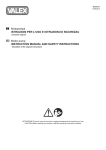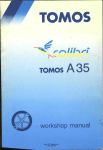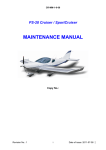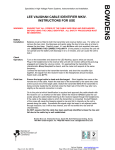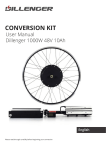Download Classic XL 45 (English)
Transcript
CLASSIC OWNER’S NAME ADDRESS PHONE/E-MAIL MODEL/TIP VIN NO. DATE OF DELIVERY DEALER’S NAME DEALER’S ADDRESS All claims made within the warranty period should be submitted to an authorized service workshop, along with the warranty itself. THE DEALER’S STAMP AND SIGNITURE CLASSIC WARRANTY TABLE KM months 1.000 2 3.000 6 10.000 12 15.000 18 DATE DATE DATE DATE SERVICE SERVICE SERVICE SERVICE 20.000 24 DATE SERVICE RECORD OF RECOMENDED SERVICE INSPECTIONS (The cost of service inspection will be borne by the customer) TOMOS USER’S MANUAL CLASSIC 1 CONTENTS Warnings 3 Riding Safety Tips 3 Technical Specification 4-5 Technical Description 6-8 Vehicle operation Fuel Engine Starting Riding Engine Running-In 9 9 9 11 11 Maintenance Maintenance Operations Lubricants Gearbox Oil change 12 12 12 12 Cleaning Fuel System Cleaning Exhaust System Cleaning Vehicle Cleaning 13 13 14 15 2 Checks and Adjustments Engine Oil Level Check Bowden Adjustment Transmission Chain Adjustment Bolt and Nut Tightness Maintenance Schedule 15 15 15 16 16 17 Troubleshooting Fuel System Troubles Ignition System Troubles Troubles Causing Reduced Engine Power Gearbox Troubles 18 18 18 18 19 Tomos warranty conditions 20 WARNINGS RIDING SAFETY TIPS Prior to operating the vehicle, carefully read this User’s Manual in order to get acquainted with its operational characteristics and safe and proper operation. 1.Fuel is extremely flammable and explosive; therefore it requires special handling precautions: - Stop the engine prior to refilling the tank; - Fill the tank outdoors; never approach the tank with a lit cigarette, open flame or sparks; and - Thoroughly wipe off any spilled fuel 2. The engine should not be run in an enclosed space or nearby entrances to lower-level areas (cellars etc.). Engine exhaust gases are toxic and denser than normal atmospheric air. 3. When starting or running the engine, never touch the ignition coil, high voltage cable, ignition spark plug cap or other parts of the electrical system. 4. The vehicle is equipped with a catalysts exhaust system causing high temperatures. When the engine is running and for some time after it has stopped do not touch its hot parts: the cylinder, the cylinder head, exhaust silencer. Do not touch the brake components too. 5. When the engine is running beware of the engine’s rotating parts. No modification of the vehicle, stripping-off any parts or installing non-original spare parts is permitted. The vehicle owner is specifically warned that any modification to the exhaust system can only result in the vehicle’s deteriorated operation, without any positive effects on engine performance and causes higher air pollution. Riding a two wheeler is simple, yet it requires some skills and experience which can only be accumulated progressively. Prior to each ride, observe the following rules: 1. Check the proper functioning of all vehicle assemblies. 2. When riding, wear light-colored, preferably light-reflective clothes; ride with your lights on; avoid riding in other drivers “blind spots” to prevent danger of other drivers “overlooking” you. 3. Abide by all traffic regulations; above all, adjust your riding speed to the road conditions and your skill level. 4. Do not hand the vehicle over to any inexperience riders. 5. Prior to changing lanes, always check that this can be done safely, and signal your intention in time Be careful when riding through road crossings or passing other vehicles (including parked vehicles).. 6. Always ride with your helmet on, be properly dressed and wear boots. 7. Pay due the attention to what is going on in front of you and behind you (rear mirror) and try to anticipate events 8. The braking affects the loading on each wheel: the front braking increases; whereas braking with the rear brake only increases the braking distance while also reducing vehicle stability; hence use the rear brake with caution. 3 TECHNICAL SPECIFICATIONS Model Classic Variants A34B – 45km/h A34C – 30km/h A34D – 25km/h A34E – 20km/h Engine Type Displacement Cylinder bore diameter Piston stroke VARIANT A34B: Compression ratio Engine power Torque Maximum speed Fuel consumption single-cylinder, two-stroke air-cooled 49 cm3 38 mm 43 mm 10 : 1 1,7 kW at 4800 min-1 3,6 Nm at 3500 min-1 45 km/h 1,8/100km Starter 4 VARIANT A34C: Compression ratio Engine power Torque Maximum speed Fuel consumption 6:1 1,0 kW at 3500 min-1 3,1 Nm at 2500 min-1 30 km/h 2,2/100km VARIANT A34D: Compression ratio Engine power Torque Maximum speed Fuel consumption 6:1 1,0 kW at 3500 min-1 3,1 Nm at 2500 min-1 25 km/h 2,5/100km VARIANT A34E: Compression ratio Engine power Torque Maximum speed Fuel consumption 6:1 1,0 kW at 3500 min-1 3,1 Nm at 2500 min-1 20 km/h 2,8/100km Kick-starter or pedals Fuel Tank capacity Engine oil reservoir 4 l (incl.0,5 l reserve) 1l Suspension Front forks travel Rear shock absorber travel 70 mm 35 mm Wheels Front tire dimensions Rear tire dimensions Front tire inflation pressure Rear tire inflation pressure 2 ¼ -16 2 ¼ -16 2,2 bar 2,2 bar Electrical system Magneto Spark advance Spark plug-A24B Spark plug-A24C, A24D, A24E Spark plug electrode clear. Headlight Tail light Stop light Speedometer illumination Oil level signal light 12V 80W preset Bosna F75, BOSCH-W7AC Dimensions And weights Wheelbase 1.080 mm Total length of vehicle 1.640 mm Vehicle mass (empty fuel tank) 60 +3 kg Maximum permitted total weight 160 kg Bosna F75, Champion-L86 0,8 mm 12V 25W 12V 5W 12V 15W 12V 2W 12V 1,5W 5 TECHNICAL DESCRIPTION 1. Fuel tank cap 2. Fuel petcock 3. Carburetor, choke 4. Kick starter lever or pedals 5. Prop stand 6. Rear brake lever 7. Front brake lever Electric start pushbutton (version) 8. Throttle lever 9. Horn switch 9a. STOP switch 10. Tool bag 11. Speedometer 12. Oil level signal light 13. Chain tension adjuster 6 14. Air filter 15. Engine oil reservoir, cap 16. Luggage carrier 17. Oil pump 18. Steering lock 11 6 Fig. 1 9 12 9a 8 7 Fig. 2 7 Fig. 3 Fig. 4 8 VEHICLE OPERATION Fuel EUROSUPER 95 and two-stroke engine oil. Your vehicle is equipped with an oil pump, which adds a specified amount of oil to the petrol (approx. 2%). Pour two-stroke oil into the separate oil reservoir (15, Fig. 1) - approximately 1 liter. CAUTION! See the Warning sticker for the max. oil level near to the oil reservoir. Use only high quality fully synthetic two-stroke oil. CAUTION! Prior to starting the engine for the first time, fill the fuel tank (1, Fig. 1) with approx. 1 liter mixture of two-stroke oil and gasoline in the ratio of 1:50 (2%), then start the engine and let it run for at least 8 minutes in order to allow the oil pump to fill the suction pipe. Before this take off the oil pump cover (17, Fig. 1) and unscrew the bolt on oil pump (A, Fig. 3) and wait till oil comes from reservoir. Tighten the bolt. Engine starting Open the fuel cock (Fig. 5). Note: A – fuel supply shot, B – fuel supply on, C - reserve. If the engine is cold, press the cold start lever (B, Fig. 6). Kick start version: With the throttle fully closed, press the rear brake lever and press the kick-starter lever (4, Fig. 1) – without opening the throttle. If starting the engine when it is still warm, the throttle must be fully opened. Pedal version: With the throttle fully closed, press the rear brake lever and press the pedals (4, Fig. 1) backwards – without opening the throttle. If starting the engine when it is still warm, the throttle must be fully opened. 9 When using the choke, allow the engine to run for 10 to 20 seconds without opening the throttle. The choke start lever disengages automatically when the throttle is opened. In the case the engine is hot do not use the choke lever. Fig. 5 11 Riding The speed is controlled by the throttle lever (8, Fig. 2). Engaging the first or second gear is done by opening or closing the throttle. Avoid switching too frequently between first and second gears. In such situation you should instead reduce the throttle opening and keep the vehicle in first gear. When descending a slope, shortly open the throttle from time to time in order to improve lubrication and headlight operation. The vehicle is shut down by closing the throttle lever and switching the STOP button to the position off (9a, Fig. 4). Then close the fuel cock (position A, Fig. 5)! If the vehicle is to stay out of operation for a longer period (e.g. during winter), draining of the fuel from the carburetor cup in the following way is recommended: close the fuel cock and, by opening the throttle lever, let the engine run out automatically. Fig. 5 10 Engine Running-in Do not run the engine at full throttle during the initial 100 km. Later increase the engine loading progressively. MAINTENANCE Maintenance Operations The vehicle is easy to maintain, yet maintenance is imperative for perfect performance. Particularly important operations include regular lubrication of individual assemblies, gearbox oil changes, cleaning of parts affecting engine operation (spark plug, exhaust system, fuel system) and checking of safety-related riding components (tire pressure, operation of lights and brakes, tightness of bolts and nuts). The maintenance table defines maintenance works in certain intervals in km and months - consider whichever comes first - for the period up to 20.000 km or 24 months. draining plug (3, Fig. 7) and pour approx. 300 cm3 of oil through the refilling opening (1, Fig. 7), so that oil level reaches the control opening (2, Fig. 7). Then, retighten the oil refilling and control opening plugs. Lubricants For the gearbox apply the automatic gearbox oil: ATF A or ATF F. For lubrication of other vehicle components (see the maintenance schedule), application of SAE 30 grade engine oil and LIS 2 grease is recommended. Gearbox Oil Change Oil should be changed when the engine is still warm. Remove the right side shield; release three threaded plugs (1, 2, 3, Fig. 7) on the right side of the engine casing, and let the oil drain completely. Retighten oil 12 Fig. 7 CLEANING Fuel System Cleaning (Fig. 8) As regards the fuel system, periodic cleaning of the main jet, air filter and fuel petcock filter is required. Do not use metal objects to clean the main jet; clean it with an air jet. Filter – sponge should be washed thoroughly in gasoline. After washing, squeeze gasoline from the sponge (do not brush it) and dry the sponge in a dry air jet. Fig. 8 13 Exhaust system cleaning (Fig. 9) The build up of soot in the exhaust system obstructs the free passage of exhaust gas and thereby reduces engine power. Periodically, clean the cylinder exhaust duct, exhaust pipe inlet opening, piston crown and cylinder compression chamber (Fig.10). Caution: exhaust system is equipped with catalysts, so do not enter into the exhaust pipe with any tools, wires, do not pour in any fluid, etc. Any such intervention can cause damage of the catalysts. We strongly suggest making exhaust system cleaning by an authorized service agent. Fig. 10 Fig. 9 14 Vehicle cleaning Vehicle exterior cleaning is also part of regular maintenance. After washing, wipe the vehicle dry. Protect painted surfaces with paint protection agents. After cleaning, check the operation of the engine, the lights and brakes. CHECK AND ADJUSTMENTS Engine Oil Level Check Check regularly the oil level in the oil tank. Top up as required. Should the warning light fail to extinguish after starting the engine, this means the oil level is low and immediate topping up is required. Caution: Kick-starter and pedals version: the warning light lights few seconds after starting the engine. If does not, the fault should be remedied. Fig. 11 Bowden Adjustment Bowden brakes are adjusted by means of the bolts on the wheels hubs. The Bowden is properly set when the brake lever free travel is 10-15 mm and the sleeve – lever gap is approx. 3 mm (Fig. 11). After adjusting, make sure the jam nut is retightened. 15 Transmission Chain Adjustment The chain tension should be adjusted so that the chain yields 10 mm up or down under pressure (Fig. 12). Adjust the chain tension by spinning the chain tension adjuster (13, Fig. 1) on the rear wheel axle. After the adjustment, retighten the nuts on the both side of axle that were party released for the adjusting. Fig. 12 16 Bolt and Nut Tightness Periodically check and retighten as necessary the bolts and nuts of the main vehicle components (wheels, handlebar, shock absorber, rear fork axis, engine to frame bolts, gearbox oil drain plug). MAINTENANCE SCHEDULE Interval (km) 1.000 3.000 Interval (months) Oil lubrication 1. Gearbox oil change 2. Bowdens (internal cables) 2 6 • • As necessary • 3. • • • Chain Greasing 4. Rear fork bearing bushes 5. Steering bearings 10.000, 15.000, 20.000 12, 18, 24 As necessary • Cleaning 6. Spark plug 7. Air filter (oiling) 8. Cylinder head, piston head, As necessary • • Interval (km) 1.000 3.000 2 6 10.000, 15.000, 20.000 12, 18, 24 • • • • • • • • • 13. Brake operation check and adj. • • • 14. Steering bearing clearance 15. Wheel bearing clearance 16. Wheel track • • • • • • • • • Tire pressure 17. (front and rear 2,2 bar) • • • 18. Chain tension • • • Interval (months) Checks and adjustments 10. Gearbox oil level 11. Horn and lights 12. Spark plug electrode clearance exhaust duct 17 • 9. 18 • 19. Cylinder and exhaust pipe Idle run and throttle • • • 20. Bolt and nut tightness • • • • • TROUBLESHOOTING Fuel System Troubles Possible causes of the engine failing to start or stopping during a ride Include, but are not limited to: - Fuel is not supplied to the carburetor: Check the fuel tank level and the position of the fuel cock. - Clogged fuel strainers: Blow the strainers clean. - Clogged carburetor main jet: Remove and blow clean. - Improper use of the choke lever: Use the lever in accordance with the engine start instructions. - Low engine idle speed setting: Using the adjustment bolt (A, Fig. 6), increase the engine speed - Spark plug cap improperly mounted or short-circuiting to the Ground mass: Properly mount the cap on the spark plug or replace with a new cap. - Ignition coil: Have the trouble examined and remedied by an authorized service agent. Troubles Causing Reduced Engine Power Possible causes of reduced engine power and reduced vehicle road performance include: - Inadequate spark plug or cylinder head tightness: Tighten the spark plug or the cylinder head nuts. - Clogged air cleaner on the carburetor: Wash in gasoline, blow dry and oil lightly. - Clogged exhaust system: clean. Ignition System Troubles Check the spark. Possible causes of the ignition spark plug failing to produce a spark include: - Wet spark or electrodes in a short circuit: - Spark plug electrodes frequently in a short circuit: Clean soot build-up from the cylinder head and piston head. - Spark plug electrodes are worn out: Adjust the electrode clearance according to the specifications, or Replace the spark plug with a new one. 19 Gearbox Troubles - Following the start, the engine runs at idle speed. If opening the throttle fails to engage the clutch: Release the throttle and attempt to start the vehicle again (the oil is still cold and thicker). When riding, open the throttle gradually to prevent engine jerks. If the problem is frequent, have it repaired by an authorized service agent. - The clutch slides (particularly in cold weather): Improper oil type in the gearbox - change with the specified oil. - The clutch takes excessively long to switch to the second gear or does not switch at all: Reduced engine power - clean the exhaust silencer; The clutch is stuck - try to activate the clutch at higher engine revs, with the vehicle propped up on a stand; Excessive amount of oil in the gearbox - check the oil level. - After engaging the second gear, the clutch jerks: Chain is too loose - adjust the chain? tension; Low gearbox oil level - top up to the specified level. - With the engine shut down, it is difficult to move the vehicle forwardsbackwards: Have the trouble examined by an authorized service agent. 20 TOMOS WARRANTY CONDITIONS Tomos d. o. o., motoindustrija guarantees the buyer: - That the product shall operate fault-free during the warranty period, provided that the user follows the enclosed technical instructions; - That the product has the required characteristics in terms of quality, as is defined in the instructions; - That it will settle any and all repair costs arising from a defect in the material or from an error in assembly; - That it will replace the product with a new one if, during the warranty period, the authorized service workshop fails to address the problem in 45 days from the date of notification; - That the warranty period shall be extended for the entire duration of the repair period; - That it will provide service and spare parts for at least 4 years after the date of purchase. The warranty period shall cover 12 months from the date of sale. This warranty shall not apply: - In cases of defects caused by the owner, defects due to improper maintenance and The • TOMOS warranty shall not apply if proven that the defects have been caused by: Improper motorcycle maintenance and disregarding the instructions provided in the • TOMOS overhaul manual; • Fitting parts on the motorcycle, or modifications or adaptations prohibited by TOMOS; • Motorcycle repairs performed by a workshop not authorized by TOMOS; Improper use of the motorcycle (for example: participation in races, overload, non-use of • the motorcycle for extended periods of time); In case the vehicle is damaged to the extent where its repairs or mending to a full work• ing order would amount to more than 15 % of the factory sale price. Normal wear of parts. 20 The warranty does not cover parts with normal wear, such as: Tires, wiring, spark plugs, graphics (stickers), fuel tank cap, lights, chains, brackets, brake pads, air and oil filters, saddles and exhaust pipes (internal inspection); the same applies for the motorcycle frame, piston holes, yellowing of chrome plating, damage due to improper adjustments, bad oil/fuel mixture or low oil level, which is also not covered by this warranty. Vehicle parts with limited warranty period (6 months) - battery; - footrests; - stands. This contract warranty does not cover the following expenses: costs of normal repair works, oil, grease etc., emergency repair costs, motorcycle immobilization costs, and costs of removal and damages of carried goods. Warranty rights The buyer can exercise their warranty rights on the basis of a duly filled in warranty certificate, verified by an authorized dealer and a confirmed coupon of a pre-delivery service by an authorized service workshop. WARNING: If it is found that a silencer or an air filter was used that is not an original part of the motorcycle, or if the original parts were modified in any way in order to increase the motorcycle noise level, the warranty is cancelled. In addition, the abovementioned adjustments that increase the noise level, power and speed of the motorcycle are under total responsibility of the owner. NOTE: In case of damage occurring in any of the neighboring countries, please present the warranty claim to your dealer, together with the relevant invoices for any defective parts. *Depends on market TOMOS






























